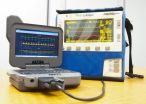(Press-News.org) Automated analysis of the vital signs commonly monitored in patients being transported to trauma centers could significantly improve the ability to diagnose those with life-threatening bleeding before they arrive at the hospital, potentially saving their lives. In the May issue of the journal Shock, a research team from Massachusetts General Hospital (MGH), the U.S. Army, air ambulance service Boston MedFlight, and two other Boston trauma centers report successful field testing of a system that simultaneously analyzed blood pressure, heart rate, and breathing patterns during emergency transport, finding that it accurately detected most cases of life-threatening bleeding in a fully automated fashion.
"Providing faster care to patients who are bleeding to death saves lives," says Andrew Reisner, MD, MGH Department of Emergency Medicine and senior author of the Shock paper. "While the clinical information that ambulance crews call in to trauma centers was sufficient to determine the presence of a life-threatening hemorrhage in about half the patients we studied, many other patients were in a 'grey area' and may or may not have been at risk of bleeding to death. Our study demonstrated that automated analysis of patients' vital signs during prehospital transport was significantly better at discriminating between patients who did and did not have life-threatening hemorrhage. Receiving more reliable information before the patient arrives can help hospitals be ready for immediate surgery and replenishment of lost blood without wasting time and resources on false alarms."
Study corresponding author Jaques Reifman, PhD, U.S. Army Medical Research and Materiel Command (USAMRMC), adds, "This system provides an automated indicator of injury severity, an objective way for clinicians to prioritize care. Care prioritization or triage is a very important problem in military medicine, when there may be more injured casualties than caregivers. In those situations the ability to wisely choose who needs priority care is truly a matter of life and death."
While teams transporting patients either by air or ground ambulance regularly notify receiving hospitals of potentially deadly injuries, the information transmitted may be too general to identify those at risk of life-threatening bleeding. Even when a patient is clearly at risk of serious blood loss, decisions about the need for surgical repair and blood transfusions may not be made until assessment is completed at the trauma center. To investigate whether computerized analysis of data being gathered by vital signs monitors during transport could identify patients with dangerous bleeding, the research team developed software based on statistical techniques currently used in stock market trading and manufacturing to determine whether particular data points represent real problems and not random fluctuations.
The system dubbed APPRAISE (Automated Processing of the Physiological Registry for Assessment of Injury Severity) - consisting of an ultracompact personal computer networked to a standard patient monitor - was installed in two MedFlight helicopters and collected data on more than 200 trauma patients transported to participating Boston hospitals from February 2010 to December 2012. In order that patient care not be affected by a still-unproven system, the analysis conducted by the APPRAISE system was not provided to MedFlight crews. The researchers also analyzed data gathered in a 2005 study of vital sign data gathered manually by a Houston-based air ambulance system. Outcomes information for both patient groups was gathered by chart review.
In both groups, the pattern-recognition capability provided by the APPRAISE system - which was able to simultaneously combine measures of blood pressure with those of heart rate, breathing and the amount of blood pumped with each heartbeat - successfully identified 75 to 80 percent of patients with life-threatening bleeding, compared with 50 percent who were identified by standard clinical practice. Notifications provided by the system would have been available within 10 minutes of initial monitoring and as much as 20 to 40 minutes before patients arrival at the trauma centers.
"The fact that decisions to proceed with surgery or to replenish lost blood often occur only after patients' arrival means there are delays - sometimes brief but sometimes prolonged - in initiating such life-saving interventions," says Reisner, an assistant professor of Emergency Medicine at Harvard Medical School. "We are now working on a follow-up study to use this system in actual trauma care and will be measuring whether it truly leads to faster treatment of life-threatening hemorrhage and better patient outcomes. This approach could also be helpful for patients transported by ground ambulance and for hospitalized patients at risk of unexpected hemorrhage, such as during recovery from major surgery."
Reifman adds, "Uncontrolled bleeding is the single most important cause of preventable combat death among our troops, and the first challenge of combat casualty care is to identify who is and who isn't bleeding to death so that available resources can be concentrated on those who most need aid. Evacuation and treatment of injured soldiers can be challenging in locations where active fighting or other hazardous conditions are present, and first responders may be inexperienced, distracted or exhausted. The APPRAISE system's automated, objective assessment of vital signs would rationally determine who needs priority care during military operations."
INFORMATION:
Jianbo Liu of the USAMRMC is lead author of the Shock paper. Other co-authors are Maxim Khitrov, USAMRMC; Erin Kittell, MGH Emergency Medicine; Marc de Moya, MD, MGH Surgery; Jonathan Gates, MD, and Joaquim Havens, MD, Brigham and Women's Hospital; Stephen Odom, MD, Beth Israel Deaconess Medical Center; and Kevin Wilkins and Suzanne Wedel, MD, Boston Medflight. The study was supported by Department of Defense Medical Research and Development Program Grant D10 IAR J6 773 and by the USAMRMC Combat Casualty Care Research Area Directorate. The U.S. Army has been granted patents on the APPRAISE system.
Massachusetts General Hospital, founded in 1811, is the original and largest teaching hospital of Harvard Medical School. The MGH conducts the largest hospital-based research program in the United States, with an annual research budget of more than $760 million and major research centers in AIDS, cardiovascular research, cancer, computational and integrative biology, cutaneous biology, human genetics, medical imaging, neurodegenerative disorders, regenerative medicine, reproductive biology, systems biology, transplantation biology and photomedicine.
Scientists have made an important step towards understanding how volcanic eruptions happen, after identifying a previously unrecognised potential trigger.
An international team of researchers from the University of Liverpool, Monash University and the University of Newcastle (Australia) think their findings could lead to new ways of interpreting signs of volcanic unrest measured by satellites and surface observations.
Dr Janine Kavanagh, from the University of Liverpool's School of Environmental Sciences and lead author of the research paper, said: "Understanding the ...
Led by Georgia State University, researchers have developed the first robust and noninvasive detection of early stage liver cancer and liver metastases, in addition to other liver diseases, such as cirrhosis and liver fibrosis.
Their findings were published Wednesday (May 13) in Proceedings of the National Academy of Sciences.
More than 700,000 people are diagnosed with liver cancer each year. It is the leading cause of cancer deaths worldwide, accounting for more than 600,000 deaths annually, according to the American Cancer Society. The rate of liver cancer in the ...
The combination of a cholesterol-lowering drug, Bezafibrate, and a contraceptive steroid, Medroxyprogesterone Acetate, could be an effective, non-toxic treatment for a range of cancers, researchers at the University of Birmingham have found.
The findings published in the journal Cancer Research show that the drugs kill cancer cells in a completely new way.
Early stage clinical trials of the drugs in elderly patients with acute myeloid leukaemia (AML) have shown promising results, with survival three months longer on average than standard palliative care. The combination, ...
Alexandria, VA - The evolutionary age of grass has been hotly contested. Scientists have previously dated the earliest grasses to 55 million years ago; after the dinosaurs went extinct. Now, a new 100-million-year-old specimen of amber from Myanmar potentially pushes back grass evolution to the Late Cretaceous.
Scientists from the Oregon State University who studied the amber believe they identified "spikelet" - grass in its flowering state - and a cluster of fossilized ergot, a major ingredient in LSD. While their conclusions are intriguing, and have implications for ...
The knock-on effects of the economic downturn have been explored in economy and psychology. Now researchers are examining the effects of unemployment on an even darker subject - cancer mortality.
One would think that dealing with unemployment was challenge enough. But according to the latest research published in ecancermedicalscience, rises in unemployment are associated with significant increases in prostate cancer mortality.
This is the first study that has systematically explored the consequences that changes in unemployment - in particular the Great Recession ...
ALEXANDRIA, Va. - The American Society of Clinical Oncology (ASCO) today announced results from four major studies to be presented at ASCO's 51st Annual Meeting, May 29-June 2, in Chicago. Findings showed that use of a widely available vitamin pill reduces the risk of non-melanoma skin cancers; that early chemotherapy extends the lives of men with advanced prostate cancers; and that new therapies can improve outcomes for children with a rare form of kidney cancer and adults with relapsed multiple myeloma.
The studies are among the around 5,000 abstracts publicly released ...
WASHINGTON - A special issue of American Psychologist provides a comprehensive review of over 40 years of research on bullying among school age youth, documenting the current understanding of the complexity of the issue and suggesting directions for future research.
"The lore of bullies has long permeated literature and popular culture. Yet bullying as a distinct form of interpersonal aggression was not systematically studied until the 1970s. Attention to the topic has since grown exponentially," said Shelley Hymel, PhD, professor of human development, learning and culture ...
LOS ANGELES (May 14, 2015) - Millions of people afflicted by irritable bowel syndrome can now be diagnosed quickly and accurately with two simple blood tests developed by a Cedars-Sinai gastroenterologist.
The tests, created by Mark Pimentel, MD, director of the GI Motility Program and Laboratory, confirm when a patient has developed IBS because of food poisoning, a major cause of the disorder.
Toxins produced by bacteria, such as salmonella, can severely harm the digestive system by damaging nerves critical to healthy gut function. The new blood tests identify the ...
Researchers have published results in Environmental Research Letters confirming strong warming in the upper troposphere, known colloquially as the tropospheric hotspot. The hot has been long expected as part of global warming theory and appears in many global climate models.
The inability to detect this hotspot previously has been used by those who doubt man-made global warming to suggest climate change is not occurring as a result of increasing carbon dioxide emissions.
"Using more recent data and better analysis methods we have been able to re-examine the global weather ...
A new report by the Nuffield Council on Bioethics calls for a change in culture across all areas of children's health research, so that children's and young people's views and opinions can help to shape how research is prioritised, designed and reviewed. Unless ethical concerns about asking children to take part in research are addressed, our understanding of childhood disorders and ability to provide evidence based care will remain limited.
"It will always be easier to say 'no' to research with children on the grounds that it's too difficult, but we should challenge ...

